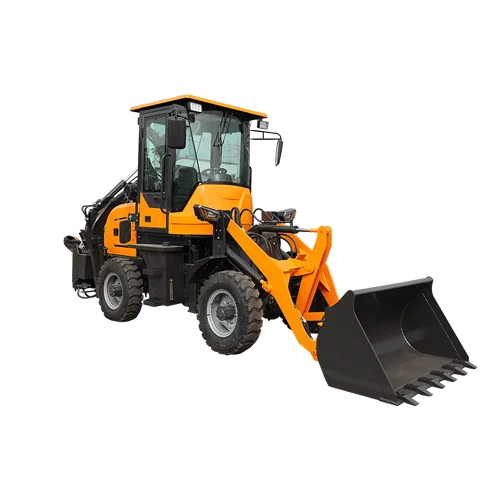Introduction

Small loader backhoe tractors have revolutionized construction sites worldwide by combining the functionality of a loader and a backhoe into a single, compact machine. These versatile vehicles excel in a variety of tasks, from digging and trenching to material handling and lifting. In this comprehensive blog post, we will delve into how small loader backhoe tractors significantly enhance efficiency on construction sites, explore their key features, applications, real-world examples, and address common questions about their usage.
Key Features of Small Loader Backhoe Tractors
Small loader backhoe tractors are engineered with several distinctive features that make them indispensable in the construction industry:
- Compact Size: Designed to navigate through narrow spaces and maneuver around obstacles, making them ideal for urban construction projects or confined work areas.
- Dual Functionality: Equipped with a front loader bucket for lifting and carrying materials, and a rear-mounted backhoe for digging, trenching, and excavating.
- Versatility: Capable of quickly switching between loader and backhoe functions, which enhances operational flexibility and efficiency on-site.
- Ease of Operation: User-friendly controls and ergonomic design ensure operators can work comfortably and efficiently for extended periods.
Advantages of Using Small Loader Backhoe Tractors
Versatility and Flexibility
The versatility of small loader backhoe tractors allows them to perform a wide range of tasks, reducing the need for multiple pieces of equipment on-site. From excavation and trenching to loading and lifting materials, these machines streamline operations and improve productivity.
Efficiency in Tight Spaces
Their compact design enables small loader backhoe tractors to access and operate in areas where larger equipment would struggle. This capability is crucial in urban construction projects where space constraints are common, allowing for efficient completion of tasks without compromising on performance.
Cost-Effectiveness
Investing in a small loader backhoe tractor can yield significant cost savings for construction companies. By consolidating multiple functions into one machine, businesses can reduce equipment acquisition costs, operational expenses, and maintenance requirements.
Applications of Small Loader Backhoe Tractors
Small loader backhoe tractors find extensive applications across various construction sectors:
- Urban Construction: Ideal for tasks such as excavation, utility trenching, and pavement removal in urban environments where space is limited.
- Residential Projects: Used for digging foundations, landscaping, and driveway installations in residential construction sites.
- Roadwork: Essential for backfilling trenches, loading materials, and maintaining road infrastructure.
- Utility Installation: Efficiently digs trenches for laying pipes, cables, and conduits underground.
Case Studies: Real-World Examples
Case Study : Urban Redevelopment Project
In the redevelopment of downtown Cityville, small loader backhoe tractors played a pivotal role in excavating utility lines and creating foundation trenches. Their maneuverability allowed them to navigate tight streets and alleys, ensuring timely completion of critical infrastructure work despite challenging urban conditions.
Case Study : Residential Construction Site
At a residential construction site in Suburbia County, a small loader backhoe tractor was employed for various tasks, including digging trenches for drainage systems and backfilling soil around newly constructed homes. Its ability to switch between loader and backhoe functions minimized downtime and improved overall project efficiency.
Applications of Small Loader Backhoe Tractors in Construction
| Construction Task | Application of Small Loader Backhoe Tractors |
|---|---|
| Excavation | Digging trenches, foundations, and utility lines |
| Loading | Moving and transporting materials such as soil, gravel, and debris |
| Grading | Leveling and smoothing terrain for roadways and landscaping |
| Lifting | Hoisting heavy objects and equipment |
| Demolition | Breaking up and removing concrete and other structures |
| Landscaping | Shaping terrain, creating slopes, and planting |
| Snow Removal | Clearing snow from roads, sidewalks, and parking lots |
| Utility Installation | Digging and installing pipes, cables, and conduits |
Benefits for Construction Companies

Small loader backhoe tractors offer numerous benefits to construction companies:
- Enhanced Productivity: Streamlined operations and reduced reliance on manual labor.
- Operational Efficiency: Versatility and quick task turnaround times.
- Cost Savings: Lower equipment acquisition and maintenance costs compared to larger machinery.
- Improved Safety: Enhanced control and visibility for operators.
Conclusion
Small loader backhoe tractors have proven to be indispensable assets in the construction industry, offering unmatched versatility, efficiency, and cost-effectiveness. Their ability to perform multiple functions in compact spaces makes them well-suited for a wide range of construction applications, from urban redevelopment projects to residential construction and roadwork. By investing in small loader backhoe tractors, construction companies can enhance productivity, reduce costs, and improve project timelines, ultimately driving greater efficiency and success in their operations.
FAQ
Q: Are small loader backhoe tractors suitable for large-scale construction projects?
A: While small loader backhoe tractors excel in versatility and efficiency, their size and capacity may limit their use in certain aspects of large-scale projects. However, they can still be valuable for specific phases or tasks within such projects, particularly where space constraints or maneuverability are critical.
Q: What maintenance is required for small loader backhoe tractors?
A: Regular maintenance includes checking hydraulic systems, servicing engine components, and inspecting attachments for wear and tear. Following manufacturer-recommended maintenance schedules ensures optimal performance and extends the lifespan of the equipment.
